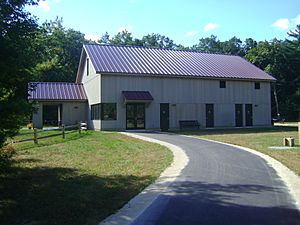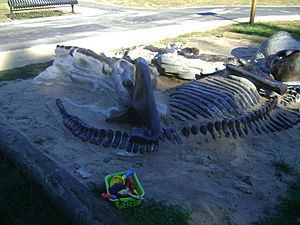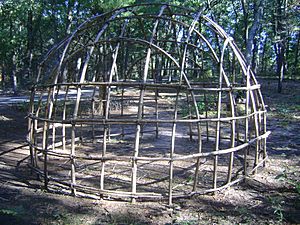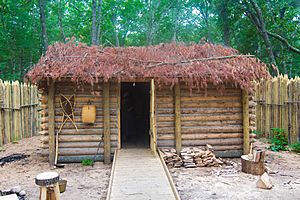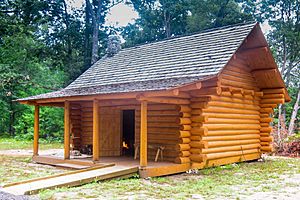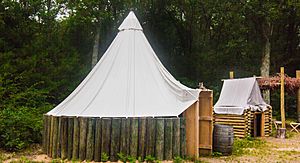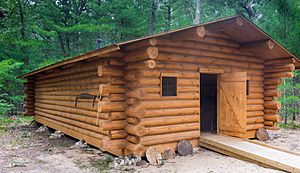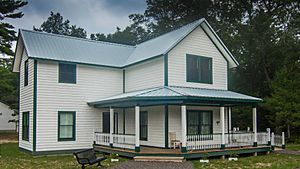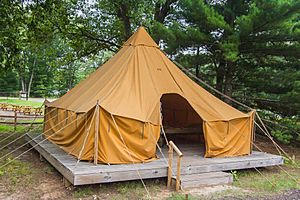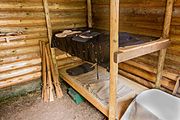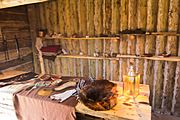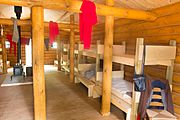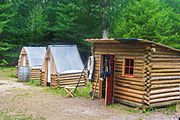Michigan Heritage Park facts for kids
Quick facts for kids Michigan Heritage Park |
|
|---|---|
| Lua error in Module:Location_map at line 420: attempt to index field 'wikibase' (a nil value). | |
| Location | 8637 N. Durham Rd, Whitehall, MI |
| Area | 19 acres (7.7 ha) |
| Governing body | Lakeshore Museum Center |
The Michigan Heritage Park was a special outdoor museum in Michigan. It showed 10,000 years of Michigan's past. Visitors could walk a half-mile trail. This trail took them from ancient times with mastodons to a Civilian Conservation Corps camp from the 1930s. All the historical exhibits were careful recreations. The Lakeshore Museum Center in Muskegon managed the park.
Contents
- History of the Park
- Journey Through Time: The Trail
- Ancient Giants: The Mastodon Site
- Digging Up the Past: Archeology Site
- Life in the Village: Native American Village
- Trading Furs: Fur Trader Cabin (1760)
- New Homes: Settler's Cabin (1830)
- Soldiers' Lives: Civil War Camp (1861–65)
- Forest Workers: Logging Shanty (1880)
- Farm Life: Michigan Farmhouse (1900)
- Helping the Country: Civilian Conservation Corps (1933)
- Gallery
History of the Park
A man named George Edward Hilt (1916–2012) had a big dream for his land. He owned property called Hilt's Landing in Whitehall Township, Michigan. Before he passed away, he planned for his land to teach future generations about Michigan's history.
He set aside over $2 million in a trust fund. This money was for creating the Michigan Heritage Trail at Hilt's Landing. Part of the money helped build the park with the Lakeshore Museum Center. The rest was for keeping the park running. It took almost ten years to make his dream a reality.
The 19-acre outdoor museum opened on June 6, 2015. It had a visitor center for guests. The park was open during warmer months, from June through October. Many local people and groups donated millions of dollars to the park. The Consumers Energy Foundation was one of the biggest donors. The park was part of a larger project called Heritage Landing. This project was meant to be a new fun spot in Muskegon. Voters helped fund it by passing a special proposal in 2011. To make the exhibits look real, staff had to use old building methods.
In November 2018, the Michigan Heritage Park closed its doors. The museum's director explained that it cost too much to run the park. The money earned from visitors was not enough to cover the costs.
Journey Through Time: The Trail
The park's trail was like a journey through 10,000 years of Michigan's past. Along the way, you could see many different exhibits. These included the Mastodon Site, an Archeology Site, a Native American Village, and a French Fur Trader Cabin. There was also a Colonial Cabin, a Civil War Camp, a Logging Shanty, and a Michigan Farmhouse. The trail ended at a Civilian Conservation Corps camp. Visitors were encouraged to try activities. This helped them learn by doing, not just by listening.
Ancient Giants: The Mastodon Site
Your half-mile tour began at the Mastodon Site. Mastodons were huge, elephant-like animals. They lived about 10,000 years ago. These giant creatures once roamed all over Michigan. Their ancient bones have been found in many parts of the state. For example, a farmer found some mastodon fossils in 1904. This discovery happened in nearby Moorland Township, Michigan.
Digging Up the Past: Archeology Site
This area was set up for archaeological digs. Park staff and volunteers could carefully dig into the soil here. They searched for old artifacts. These finds might include fossils, tools made by American Indians, or pieces of pottery. They also looked for parts of old farm equipment that had been left behind.
Life in the Village: Native American Village
The Native American Village, also called "Wigwam Village," showed how the Anishinabe people lived. This was around the mid-1600s, when they first met Europeans. These Native Americans spoke the Algonquin language. They formed the Council of Three Fires. Today, their descendants are the Michigan tribes of the Odawa, Potawatomi, and Ojibwe Chippewa. Visitors could learn how they prepared food, made clothes, and built homes.
Wigwams were the main homes for Native American families in Michigan. Up to six people could live in one. Building wigwams needed animal skins and many types of wood. These included birch, pine, maple, and oak. The timing for construction was important. The bark had to be stripped and used within two days. This kept it flexible enough to bend into the wigwam's shape.
When the park rebuilt two wigwams, they learned a lot. It took much more work and skill than they first thought. The park's wigwams did not have a smoke hole in the center. Real Native American wigwams would have had one. This hole let smoke escape from fires used for warmth and cooking. The park used jute and metal rebar to make their wigwams strong. These were display models, not real homes. The two wigwams built by the park were about 12 by 15 feet at the base.
Trading Furs: Fur Trader Cabin (1760)
Early European explorers came to the New World looking for gold. They also hoped to find a quick way to Asia. But they soon realized that fur-bearing animals were very valuable. Native Americans trapped these animals. Europeans wanted beaver fur to make felt hats. So, they traded European goods for these animal pelts. One of the most popular trade items was the Hudson's Bay point blanket. These wool blankets were highly desired by Native Americans. They traded them for beaver pelts, buffalo robes, and moccasins. Visitors could take part in trading games. This helped them learn how Europeans and Native Americans traded in the 1700s.
The French Fur Trader Cabin showed a common French building style. It used poles set into the ground. The end walls were made of logs stacked on top of each other. Outer poles held them in place. This method was called poteau en terre construction. The park's cabin was based on an old trading post found in Wisconsin.
The park's cabin had strong boards to support heavy Michigan snow. The roof was covered with modern waterproof material. Then, hand-split maple shingles were added. This made it look like a real historical building. The cabin also had a wooden fence, or stockade wall, around it. This showed what a trading post might have looked like back then.
New Homes: Settler's Cabin (1830)
In 1830, Michigan had about 32,000 people. These early settlers often built log cabins. This was because Michigan had so many forests. This Settlers Cabin shows a typical simple home from the mid-1800s. They were usually built quickly with round logs, not carefully shaped ones. These cabins provided quick shelter on the frontier.
The recreated 1830 Settlers Cabin was the fifth stop on the trail. Guides showed what daily life was like during this time. For example, sometimes a guide would show how to spin wool on the front porch. Other tasks included churning butter, making candles, and grinding coffee.
Soldiers' Lives: Civil War Camp (1861–65)
The American Civil War began in April 1861 at Fort Sumter. Michigan sent 90,000 men to fight in the war. About 15,000 of them died. More than 9,000 of these deaths were due to disease. Michigan soldiers fought in many other states. They spent a lot of time in camps, like the one shown here. These camps were often dirty, and hygiene was poor. The recreated private's quarters shows what a winter camp was like for Michigan soldiers.
Some of the wooden buildings were very small. They were no bigger than a dog house. Two grown men would share this tiny space. Other parts of military life were also shown at this stop. These included soldiers' food, their uniforms, and what they did in their free time.
Forest Workers: Logging Shanty (1880)
From 1841 to 1900, Michigan had a "golden era" of lumbering. Almost all the original forests were cut down. This exhibit showed a logging shanty. This building housed the lumberjacks. When all the trees in an area were cut, the shanty was taken down. Then, it was rebuilt in a new forest location.
This exhibit showed what work camp life was like in Michigan in the early 1880s. It showed what lumberjacks ate, how they dressed, and the hard work they did. Some visitors could even try a two-man saw demonstration. Young children were invited to climb into one of the bunk beds. They could also play checkers, just like the lumberjacks did in the evenings.
Farm Life: Michigan Farmhouse (1900)
Near the end of the tour was a Michigan Farmhouse. It showed life around the year 1900. This exhibit taught visitors about the start of farming development in Michigan. There was an apple orchard nearby. The park had plans for a garden and farm animals in the future. This would show what early farm life was truly like. Visitors were asked to try household chores. These included baking food over an open fire and weeding a garden.
In the 1900s, most people in the country lived in rural areas. Michigan's farms began to change. They started growing food not just for families, but for many others. This was the beginning of large-scale farming that we still see today. This building showed what a typical farmhouse from this time was like. There was no electricity or running water. An outhouse was used outside.
Helping the Country: Civilian Conservation Corps (1933)
The stock market crashed on October 29, 1929. This event helped cause the Great Depression. At the start of this time, 25% of the nation's workers had no jobs. Franklin D. Roosevelt became president in 1933. One of his first actions was to create programs to help. He formed the Federal Emergency Relief Administration. The Civilian Conservation Corps (CCC) was part of this effort. It created jobs for young men. Their work helped improve forests, stop soil erosion, and make soil quality better. This work also opened up public lands that were hard to reach before.
The Civilian Conservation Corps camp showed a CCC tent from 1933. It was near the Michigan farmhouse, at the end of the park tour. Groups of young people who wanted to volunteer at the park would work with staff from here. Some visitors who weren't planning to volunteer might also be asked to help.
Gallery


